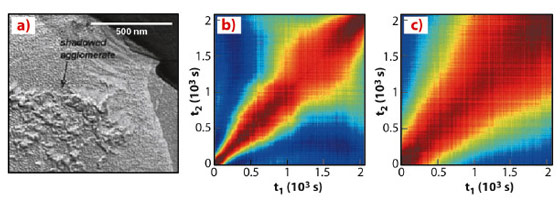- Home
- Users & Science
- Scientific Documentation
- ESRF Highlights
- ESRF Highlights 2012
- Soft condensed matter
- Anisotropic dynamics of the tenuous gel in a liquid crystal–nanoparticle composite
Anisotropic dynamics of the tenuous gel in a liquid crystal–nanoparticle composite
Liquid crystals are a particular liquid state of matter that can undergo phase transition depending on external conditions such as temperature, concentration and composition. They are abundant in living systems but are most likely known for their technological applications in electronic displays. One of the directions to tune or tailor liquid crystal properties is by introducing colloidal particles. Particles perturb the organisation of the molecules and generate defects. It was shown that a high concentration of particles immersed in a liquid crystal can produce a new class of soft solids [1].
Gelation in particle-liquid crystal mixture originates from the direct interactions between particles and the distortion to the ordering of the host solvent. The latter results in effective interactions between the particles which have been well studied in the nematic phase [1,2] and more recently explored in the cholesteric phase [3]. The consequences of the particles for the liquid crystalline ordering and associated phase transitions have been explored in some detail but the static and dynamics behaviour of the particles has received far less attention. Investigations of the structural and dynamics properties of fumed hydrophilic silica in 8CB composites using XPCS show that, at low silica concentration, the composites are able to restructure themselves in time [4] by expansion of the network structure, which was confirmed by SAXS. For higher silica concentrations the network structure remains constant. The studies [4] suggest that there may be coupling between the dynamics of the particle-gel and the the dynamics of the nematic host. Here we build on these ideas by using silica particles with controlled surface chemistry to modify the direct interactions.
We investigated the structure, ageing and dynamics of 4’-pentyl-4-biphenylcarbonitrile (5CB)-nanoparticle gels using SAXS and XPCS. The strength of the hydrogen bonding was tuned by silanisation of the fumed silica nanoparticles. Figure 83 presents the freeze-fracture electron microscopy of the composite. SAXS results show that the silica adopts a fractal structure in 5CB with only modest changes to the fractal dimension df between 1.98 and 2.26. It was confirmed that the composite samples were gels by rheology. Because the samples were opaque to visible light the dynamics was probed using XPCS with a CCD camera. We were able to quantify nonequilibrium dynamic properties and characterise the dynamics in two orthogonal directions. The dynamics of the composites show time-dependent behaviour and anisotropy evidenced by the different relaxation times in the vertical and horizontal directions. This anisotropy is not a result of sedimentation or the shape of the cell but reflects the local arrangement of nematic domains. In the same q range, the structure of the composite was isotropic. The decay of the intensity correlation functions can be described by compressed exponential functions. Quantitatively, we find that relaxation rate 1/τc varies linearly with scattering vector q for both directions. This indicated that the relaxation mechanism is not of diffusive origin (for which 1/τc ~ q2). Such behaviour has also been observed in other soft glassy systems and has been attributed to randomly distributed internal stress relaxations within the sample. The ageing observed in our liquid crystal-nanoparticle composite is consistent with slow reorganisation and has anisotropic character. We interpret ageing as being due to the slow relaxation of the composite. The longevity of these stresses is associated with the particles’ ability to form hydrogen bonds and 5CBs’ tendency to align.
Because the fumed silica induces homeotropic anchoring of the 5CB molecules at its surface, disorder is induced locally in 5CB near the particles as well. Local attempts to relax can result in a further large scale build up of stresses within the sample. After sufficient build up of internal stress the gel ‘yields’ which means that rearrangements take place which gives rise to the slow pronounced ageing that we have observed. This is not a new phenomenon as such, however, it has not previously been found to have marked anisotropy.
Principal publication and authors
D.D. van’t Zand (a), Y. Chushkin (b), L. Belkoura (c), C.V. Lobo (a), R. Strey (c), K. Lyakhova (d) and P.S. Clegg (a), Soft Matter, 8, 4062 (2012).
(a) School of Physics and Astronomy, University of Edinburgh (UK)
(b) ESRF
(c) Institute of Physical Chemistry, University of Cologne (Germany)
(d) Eindhoven University of Technology (The Netherlands)
References
[1] T.A. Wood et al., Science 334, 79 (2001).
[2] H. Stark, Phys. Rep. 351, 387 (2001).
[3] N. Hijnen, T.A. Wood, D. Wilson and P.S. Clegg, Langmuir 26, 13502 (2010).
[4] A. Roshi, S. Barjami, G.S. Iannacchione, D. Paterson and I. McNully, Phys. Rev. E 74, 031404 (2006).




